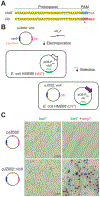Site-Directed Mutagenesis of Large Biosynthetic Gene Clusters via Oligonucleotide Recombineering and CRISPR/Cas9 Targeting
- PMID: 32584552
- PMCID: PMC8142379
- DOI: 10.1021/acssynbio.0c00265
Site-Directed Mutagenesis of Large Biosynthetic Gene Clusters via Oligonucleotide Recombineering and CRISPR/Cas9 Targeting
Abstract
Genetic engineering of natural product biosynthetic gene clusters represents an attractive approach to access new and complex bioactive small molecules. However, due to the large number and size of some genes involved in specialized metabolism, notably those encoding modular polyketide synthase and nonribosomal peptide synthetase megaproteins, it remains difficult to introduce precise genetic mutations to probe domain activity or alter chemical product formation. Here, we report the development and validation of a robust method combining oligonucleotide recombineering and CRISPR/Cas9 targeting for rapid site-directed mutagenesis of cloned pathways, which can be directly transferred to a heterologous host for expression. We rapidly generated 12 point mutations and identified several important determinants of successful mutagenesis, including the protospacer/PAM sequence and presence of regions of local homology. Our approach may be broadly applicable for researchers interested in probing natural product biosynthesis or performing pathway engineering.
Keywords: CRISPR-Cas9; biosynthetic gene cluster; heterologous expression; natural product; recombineering; site-directed mutagenesis.
Conflict of interest statement
The authors declare no competing financial interest.
Figures


Similar articles
-
Rational and efficient site-directed mutagenesis of adenylation domain alters relative yields of luminmide derivatives in vivo.Biotechnol Bioeng. 2015 Jul;112(7):1343-53. doi: 10.1002/bit.25560. Epub 2015 Mar 2. Biotechnol Bioeng. 2015. PMID: 25683597
-
CRISPR/Cas9-assisted ssDNA recombineering for site-directed mutagenesis and saturation mutagenesis of plasmid-encoded genes.Biotechnol Lett. 2023 Jun;45(5-6):629-637. doi: 10.1007/s10529-023-03363-1. Epub 2023 Mar 17. Biotechnol Lett. 2023. PMID: 36930400
-
Establishing a new methodology for genome mining and biosynthesis of polyketides and peptides through yeast molecular genetics.Chembiochem. 2012 Apr 16;13(6):846-54. doi: 10.1002/cbic.201100798. Epub 2012 Mar 23. Chembiochem. 2012. PMID: 22447505
-
Application of Cas9-Based Gene Editing to Engineering of Nonribosomal Peptide Synthetases.Chembiochem. 2025 Feb 1;26(3):e202400765. doi: 10.1002/cbic.202400765. Epub 2025 Jan 15. Chembiochem. 2025. PMID: 39741118 Review.
-
Strategies to establish the link between biosynthetic gene clusters and secondary metabolites.Fungal Genet Biol. 2019 Sep;130:107-121. doi: 10.1016/j.fgb.2019.06.001. Epub 2019 Jun 10. Fungal Genet Biol. 2019. PMID: 31195124 Review.
Cited by
-
Engineering the stambomycin modular polyketide synthase yields 37-membered mini-stambomycins.Nat Commun. 2022 Jan 26;13(1):515. doi: 10.1038/s41467-022-27955-z. Nat Commun. 2022. PMID: 35082289 Free PMC article.
-
Parallelized gene cluster editing illuminates mechanisms of epoxyketone proteasome inhibitor biosynthesis.Nucleic Acids Res. 2023 Feb 22;51(3):1488-1499. doi: 10.1093/nar/gkad009. Nucleic Acids Res. 2023. PMID: 36718812 Free PMC article.
-
Gene editing enables rapid engineering of complex antibiotic assembly lines.Nat Commun. 2021 Nov 25;12(1):6872. doi: 10.1038/s41467-021-27139-1. Nat Commun. 2021. PMID: 34824225 Free PMC article.
-
Striving for sustainable biosynthesis: discovery, diversification, and production of antimicrobial drugs in Escherichia coli.Biochem Soc Trans. 2022 Oct 31;50(5):1315-1328. doi: 10.1042/BST20220218. Biochem Soc Trans. 2022. PMID: 36196987 Free PMC article. Review.
-
Engineering Modular Polyketide Biosynthesis in Streptomyces Using CRISPR/Cas: A Practical Guide.Methods Mol Biol. 2022;2489:173-200. doi: 10.1007/978-1-0716-2273-5_10. Methods Mol Biol. 2022. PMID: 35524051
References
-
- Davies J, and Ryan KS (2012) Introducing the parvome: bioactive compounds in the microbial world. ACS Chem. Biol 7, 252–259. - PubMed
-
- Thirlway J, Lewis R, Nunns L, Al Nakeeb M, Styles M, Struck AW, Smith CP, and Micklefield J (2012) Introduction of a non-natural amino acid into a nonribosomal peptide antibiotic by modification of adenylation domain specificity. Angew. Chem., Int. Ed 51, 7181–7184. - PubMed
-
- Court DL, Swaminathan S, Yu D, Wilson H, Baker T, Bubunenko M, Sawitzke J, and Sharan SK (2003) Mini-lambda: a tractable system for chromosome and BAC engineering. Gene 315, 63–69. - PubMed
Publication types
MeSH terms
Substances
Grants and funding
LinkOut - more resources
Full Text Sources
Miscellaneous

